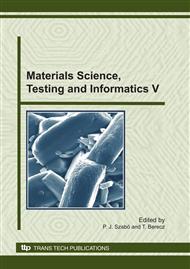p.103
p.109
p.115
p.121
p.127
p.135
p.141
p.147
p.153
Aptitude for Cold Rolling of Laser Welded Joints and their Environment in the Case of Steel Sheets
Abstract:
In order to perform a continuous cold rolling of steel sheets, hot rolled coils need to be attached to each other in order to get an endless sheet. This process can be achieved by laser key-hole welding as well. The structure and mechanical properties (e.g. hardness) of the welded joint without added metal, as well its heat affected zone differs significantly from the base metal. During our laboratory experiments the aptitude of cold rolling of joints and their environment, as well as the change in the features of materials was analyzed. During the rolling phases the hardness of the joint is higher than the ground structure, the strip thickness is modified depending on the difference of the hardness during the passes. According to our findings, the significant difference in measured hardness profile and texture structure prior to cold rolling and during cold rolling is minimized due to a recrystallisation annealing treatment following the cold rolling procedure. It is obvious that the normalization before cold rolling has advantageous effect to the properties of the welded joint. Elongation of the normalized samples is bigger than elongation of the non normalized samples.
Info:
Periodical:
Pages:
127-133
Citation:
Online since:
September 2010
Authors:
Keywords:
Price:
Сopyright:
© 2010 Trans Tech Publications Ltd. All Rights Reserved
Share:
Citation:


